LIVING WITH SUICIDE BOMBING IN ISRAEL
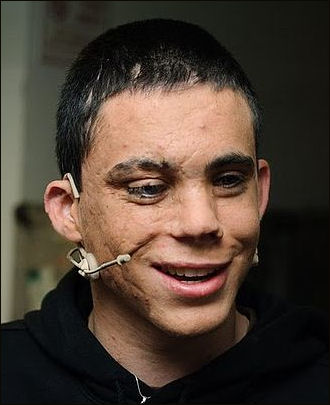
Oren Almog, blinded and
severely injured by suicide bomb Bruce Hoffman wrote in The Atlantic Monthly: “The intensified suicide-bombing campaign in Israel in the late 1990s and early 2000s “changed the national mood and people's personal politics. Nearly everywhere in the world it is taken for granted that one can simply push open the door to a restaurant, café, or bar, sit down, and order a meal or a drink. In Israel the process of entering such a place is more complicated. One often encounters an armed guard who, in addition to asking prospective patrons whether they themselves are armed, may quickly pat them down, feeling for the telltale bulge of a belt or a vest containing explosives. Establishments that cannot afford a guard or are unwilling to pass on the cost of one to customers simply keep their doors locked, responding to knocks with a quick glance through the glass and an instant judgment as to whether this or that person can safely be admitted. What would have been unimaginable a year ago is now not only routine but reassuring. It has become the price of a redefined normality. [Source: Bruce Hoffman, The Atlantic Monthly, June 2003]
In 2003 police told Hoffman, "This year there were very many events," using the bland generic noun that signifies terrorist attacks or attempted attacks. "In previous years we considered ten events as normal; now we are already at forty-three." He sighed. There were still three weeks to go before the end of the year. Nineteen of these events had been suicide bombings. In the calculus of terrorism, it doesn't get much better. "How easy it has become for a person to wake up in the morning and go off and commit suicide," he observed. Once there were only "bags on buses, not vests or belts" to contend with, the policeman said. "Everything is open now. The purpose is to prove that the police can do whatever they want but it won't help."
This, of course, is the age-old strategy of terrorists everywhere — to undermine public confidence in the ability of the authorities to protect and defend citizens, thereby creating a climate of fear and intimidation amenable to terrorist exploitation. In Jerusalem, and in Israel as a whole, this strategy has not succeeded. But it has fundamentally changed daily behavior patterns — the first step toward crushing morale and breaking the will to resist.
The terrorists appear to be deliberately homing in on the few remaining places where Israelis thought they could socialize in peace. An unprecedented string of attacks in the first four months of last year illustrated this careful strategy, beginning at bus stops and malls and moving into more private realms, such as corner supermarkets and local coffee bars.
As we had tea late one afternoon in the regal though almost preternaturally quiet surroundings of Jerusalem's King David Hotel, Benny Morris, a professor of history at Ben Gurion University, explained, "The Palestinians say they have found a strategic weapon, and suicide bombing is it. This hotel is empty. The streets are empty. They have effectively terrorized Israeli society. My wife won't use a bus anymore, only a taxi." It is undeniable that daily life in Jerusalem, and throughout Israel, has changed as a result of last year's wave of suicide bombings. Even the police have been affected. "I'm worried," one officer told me in an aside — whether in confidence or in embarrassment, I couldn't tell — as we walked past Zion Square, near where some bombs had exploded. "I tell you this as a police officer. I don't come to Jerusalem with my children anymore. I'd give back the settlements. I'd give over my bank account to live in peace."
Everyday Life and Precautions Against Terrorism in Israel When Bombings Were Frequent

Suicide bomber in Dizengoff street When suicide bombers were a threat many restaurants and shops hired their own guards who secretly scanned people with concealed metal detectors. City buses installed armor plating. Television programs and loudspeaker announcements warned people to report unattended packages. During this period shopping malls had significant drops in business. Israelis that ventured occasionally to East Jerusalem stopped going there. Roads in the Palestinian territories or bus routes that had been attacked were avoided at all costs.
Many Israelis have stories about close calls with suicide bombings (for instance they had plans to visit a place where a bomb went off but changed their mind at the last minute). But most were determined not to let terrorism disrupt their lives. Some became so fearful they were afraid to leave their houses to run simple errands. A number of restaurants, including McDonald’s, began offering home delivery. Those could afford to and had the time took long vacations overseas vacations. Some people even talked about leaving Israel for good.
Many Israelis looked for ways to avoid thinking about terrorism. Tranquilizer use rose. Book sales increased. On television people watched escapist programs, such as comedy shows and dramas rather than the news and sought New Age therapies in record numbers.
A key aspect of Israel’s fight against terrorism was to continue going about daily life and refusing to give in to fears of terrorism. Restaurants and bars in neighborhood that were bombed quickly reopened. Buses on routes that were attacked continued to run. After every attack an effort was made to clean up as quickly as possible and try to resume life as quickly as possible so the terrorists would not feel they succeeded. By contrast, in America a few attacks caused great disruptions to daily life.
In Jerusalem people try yo avoid crowds and not take the bus and keep their distance from buses when hey drive a car and keep a look for people weaning bulky clothing on a hot day.
Some Israeli avoided going to crowded markets and busy downtown areas that were often the target of bombings. Others look over their should more, jump if they hear a car backfire, scan crowds looking fir suspicious people, carry handguns and sit at the back of buses and restaurants because they feel they are safer there if a suicide bomber blows himself up at the entrance. Parents tell their children to eat quickly at fast food restaurants and pizzerias. One Israeli man told Reuters, “Israelis are now very vigilant — just look at their behavior when they enter a bus or public place, or how they react when they see a lousy package on the ground.”
Protection Against Terrorism in Israel
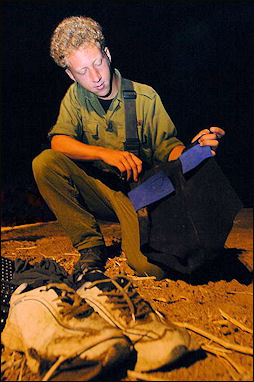
Suicide bomber stopped in Gaza Israel’s main defense against terrorism is trying to keep them from setting foot in Israel. Israel prevents potential terrorists from entering Israel from the Palestinian territories and other countries by: 1) issuing travel permits and magnetic ID cards that can be checked by computers to Palestinians that work in Israel; 2) setting up roving checkpoints and spot searches on the numerous roads that link the West Bank and Israel; 3) issuing color-coded license plates (white for the Gaza Strip, blue for the West Bank and yellow for Israel) that allow soldiers to quickly identify where vehicles are from; 4) using security fences with electric sensors and cameras; and 5) using patrols.
Many of these security measures though can be easily defeated. Security fences can be tunneled under. Licence plates can be changed. Checkpoints can be avoided. Documents can forged or tampered with.
In Israeli cities guards are posted at the entrances to markets, shopping areas, restaurants and cafes. Unmarked vehicles patrols the streets looking for suspicious people or things. Bars, shops and restaurant outfit their establishments with $10,000 worth of shatter-proof glass. After attacks and during Jewish holidays the border into Israel from the West Bank and the Gaza Strip are often closed in an effort to deter attacks. When I was in Jerusalem waiting outside the bus station for a bus I momentarily put my backpack on a park bench to take a quick piss. Within seconds a van stopped to check out the briefly unattended backpack.
Israel has robots that deactivate bombs. The Jerusalem News Service reported that an Israeli chemist named Rabbi Moshe Antelman invented a bullet designed especially for Islamic terrorists. It contains a small amount of pork so it not only kills them it defiles their soul. Some Muslims believe that any contact with pork will make their souls unclean.
The French Hill intercection in Jerusalem near the West Bank is regarded as the most dangerous place in Israel. A dozen suicide bombings have occurred here. Bus stops here are carefully monitored from Israeli Border Police posts; lookouts are posted on an overpass. Armed guards patrolling the street. Barricades are situated on the curbs and divides of the highway. At the bus stop are memorials for this killed in suicide blasts.
Israelis security forces periodically staged raids into Palestinian territory to ferret out terrorists or look for weapon caches or bombmaking labs. In May 2002, the Israelis claimed they had foiled 32 terror attacks in the previous month as the result of extensive military sweeps in the West Bank. Critics of the rough raids said that yes the sweeps may have foiled some attacks but they also left scores dead and hundreds arrested and in the end encouraged others to become suicide bombers or join the armed struggle against Israel.
Fighting Suicide Bombing in Israel in the Early 2000s
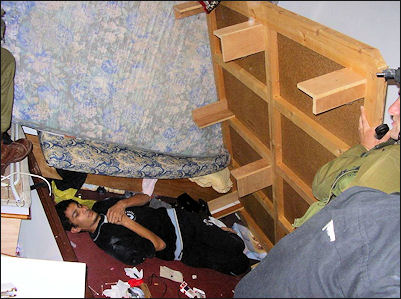
Suicide bomb planner found hiding under bed Bruce Hoffman wrote in The Atlantic Monthly: A society facing such a determined foe can respond. Israel, with its necessarily advanced military and intelligence capacities, was able in the first four months of 2002 to meet the most concerted effort to date by Palestinian terrorists to test the resolve of its government and the mettle of its citizens. The success of the IDF's strategy is utterly dependent on regularly acquiring intelligence and rapidly disseminating it to operational units that can take appropriate action. Thus the IDF [Israel Defense Force] must continue to occupy the West Bank's major population centers, so that Israeli intelligence agents can stay in close — and relatively safe — proximity to their information sources, and troops can act immediately either to round up suspects or to rescue the agent should an operation go awry. "Military pressure facilitates arrests, because you're there," one knowledgeable observer explained to me. "Not only do you know the area, but you have [covert] spotters deployed, and the whole area is under curfew anyway, so it is difficult for terrorists to move about and hide without being noticed, and more difficult for them to get out. The IDF presence facilitates intelligence gathering, and the troops can also conduct massive sweeps, house to house and block to block, pick up people, and interrogate them."[Source: Bruce Hoffman, The Atlantic Monthly, June 2003]
The IDF units in West Bank cities and towns can amass detailed knowledge of a community, identifying terrorists and their sympathizers, tracking their movements and daily routines, and observing the people with whom they associate. Agents from Shabak, Israel's General Security Service (also known as the Shin Bet), work alongside these units, participating in operations and often assigning missions. "The moment someone from Shabak comes with us, everything changes," a young soldier in an elite reconnaissance unit told me over coffee and cake in his mother's apartment. "The Shabak guy talks in Arabic to [the suspect] without an accent, or appears as an Arab guy himself. Shabak already knows everything about them, and that is such a shock to them. So they are afraid, and they will tell Shabak everything." The success of Defensive Shield and the subsequent Operation Determined Way depends on this synchronization of intelligence and operations. A junior officer well acquainted with this environment says, "Whoever has better intelligence is the winner."
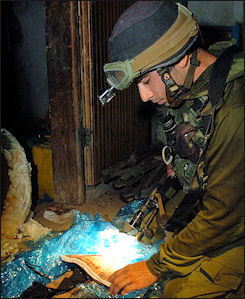
Explosive belt found in water heater The strategy — at least in the short run — is working. The dramatic decline in the number of suicide operations since last spring is proof enough. "Tactically, we are doing everything we can," a senior officer involved in the framing of this policy told me, "and we have managed to prevent eighty percent of all attempts." Another officer said, "We are now bringing the war to them. We do it so that we fight the war in their homes rather than in our homes. We try to make certain that we fight on their ground, where we can have the maximum advantage." The goal of the IDF, though, is not simply to fight in a manner that plays to its strength; the goal is to actively shrink the time and space in which the suicide bombers and their operational commanders, logisticians, and handlers function — to stop them before they can cross the Green Line, by threatening their personal safety and putting them on the defensive.
One senior IDF commander said, "It is better for the IDF to bear the brunt of these attacks than Israeli civilians. The IDF is better prepared, protected, educated." Thus security in Israel means to the IDF an almost indefinite deployment in the West Bank — a state of ongoing low-level war. For Palestinian civilians it means no respite from roadblocks and identity checks, cordon-and-search operations, lightning snatch-and-grabs, bombing raids, helicopter strikes, ground attacks, and other countermeasures that have turned densely populated civilian areas into war zones.
Many Israelis do not relish involvement in this protracted war of attrition, but even more of them accept that there is no alternative. "Israel's ability to stand fast indefinitely is a tremendous advantage," says Dan Schueftan, an Israeli strategist and military thinker who teaches at Haifa University, "since the suicide bombers believe that time is on their side. It imposes a strain on the army, yes, but this is what the army is for." Indeed, no Israeli with whom I spoke on this visit doubted that the IDF's continued heavy presence in the West Bank was directly responsible for the drop in the number of suicide bombings. And I encountered very few who favored withdrawing the IDF from the West Bank. This view cut across ideological and demographic lines. As we dined one evening at Matza, which has been rebuilt, a centrist graduate student at Haifa University named Uzi Nisim told me that Palestinian terrorists "will have the power to hit us, to hurt us, once [the IDF] withdraws from Jenin and elsewhere on the West Bank." Ami Pedahzur, of Haifa University, who is a leftist, agreed. He said, "There is widespread recognition in Israel that this is the only way to stop terrorism." I later heard the same thing from a South African couple, relatively new immigrants to Israel who are active in a variety of human-rights endeavors. "Just the other day," the husband told me, "even my wife said, 'Thank God we have Sharon. Otherwise I wouldn't feel safe going out.'"
Buffer Zone Between Israel and the West Bank
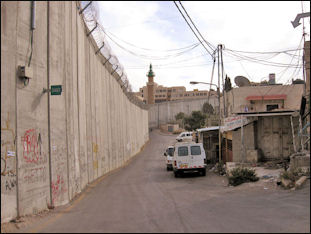
West Bank wall When Ariel Sharon was the Prime Minister of Israel, rather than make a peace deal he called for the establishment of “buffer zones” to protect Israelis from Palestinian militants and suicide bombers. The policy, dubbed “unilateral separation,” called for spending $400 million to set up an elaborate system of fences, checkpoints and military patrols, running roughly along the 240-mile pre-1967 border with the West Bank (“the Green Line”) and leaving the 150,000 or so Jewish settlers in places guarded by the Israeli army. Some settlements along the border area in the West Bank were placed on the Israeli side of the fence.
Most Israelis supported the fence as a necessary security measure. Among those that didn’t were Jewish settlers who were be fenced in, people who said fences recalled the fences built around Jews in the Holocaust, and right wing conservatives who wanted the Israeli government to claim the West Bank as part of Israel.
Most Palestinians oppose the fence. They argued hurt the Palestinian economy by impeding the flow of goods and workers between Israel and the Palestinian territories. Palestinians also complain the fence cuts them off from neighboring towns and villages and prevented from getting to work and school.
The United Nations General Assembly has demanded that construction of the fence be stopped, saying it was a violation of a United Nations resolution. In July 2004, the Israeli Supreme Court ruled that a key 40-kilometer section of the wall near Jerusalem had to be rerouted because its previous location caused too much hardship for the Palestinians that lived there. In September 2005, an Israeli court ruled that Israel had the right to build the wall on occupied West Bank, effectively rejecting a World Court decision that such a move was illegal.
Between 2000 and July 2003, before the wall was built, according to statistics published by the Israeli government, 73 Palestinian suicide bombings were carried out from the West Bank, killing 293 Israelis and injuring over 1,900. However, from August 2003 and the end of 2006, after the first sectiosn of the wall were built only 12 attacks were carried out, killing 64 Israelis and wounding 445. Supporters of wall have said these statistics indicate the barrier’s effectiveness.
Fence Between Israel and the West Bank

Israeli-West-Bank barrier at Ramallah The barrier that stands between Israel and the West Bank is 50 meters wide with a three-meter-high fence in the middle. The fence runs for 680 kilometers and is outfit with electronic sensors that can detect encroachments. In some places walls of concrete have been built. On the Palestinian side of the fence is a two-meter deep ditch designed to stop vehicles. On the Israeli side is paved road used by border police. Beyond the ditch and road are two-meter-high rolls of barbed wire. Surveillance cameras aimed at the fence are spaced at regular intervals. In places where Palestinian snipers might have an open shot at Israeli civilians guards are posted.
In some places the fence extends far into the West Bank to protect Jewish settlements there. Part of the barrier is patrolled by drones that are heavily armed and have sophisticated sensors but have no crews. The vehicles are about the size of car and equipped with recorded messages to warn suspected infiltrators and the firepower to blow them away. The fence is in addition to other fences — usually just ditches with rolls of barbed wire — placed every day in the West Bank to isolate Palestinian populations and protect Jewish settlers.
Work began on a 60-mile, $100 million section of fence built along the northwest border of the West Bank in 2002. It consisted of a stomach-high, two-bar fence, sided by a ditch and a gravel road, and mounds of dirt and concrete blocks to block off roads. The ditch stopped vehicles but old ladies with heavy bags were able to easily wall easily under the fence. This fence was regarded as only a first step before a more elaborate fence could be built. The first section was completed in July 2003. Its main purpose was to help protect Israeli towns like Haifa.As of 2004, the barrier was a forth complete. As of 2012 the barrier about two thirds finished.
Similar barriers have been built: 1) between Israel and the Gaza Strip; 2) between Gaza and Egypt; and 3) along Israel’s northern border with Lebanon. Different parts have been built at different times and some sections are accompanied by several-kilometers -wide buffer zones and no-mans-land established for security reasons. It is unclear how the main wall West Bank will be constructed through Jerusalem. Any plan will leave some Israelis on the Palestinian side and some Palestinians on the Israeli side.
Foiled Terrorist Attacks

Captured attackers A number of attacks have been foiled by police and observant bystanders or because the bombers were careless, acted suspiciously, had trouble with their explosives or backed out at the last minute. Bombers have been discovered through intelligence work or caught before they could detonate their bombs. Bombs left in bags and found and detonated before they go off. According to some estimates only about 20 percent of suicide bombers manage to kill or injure anybody and only 5 percent of the attacks kill more than five people.
Many credit local Israeli police with foiling many attacks. A police official told Reuters that the strength of the police “is that they are almost always on the same turf, they know the populations, all the access routes and all the problems.” If an gun attack occurs soldiers and police respond very quickly and usually shoot the gunman before he can kill many people.
Often times suicide bombers give themselves away. The same police official told Reuters “The terrorist who comes to carry out an attack, I don’t want to say it’s body language that sends the message because that sounds too far fetched, but it’s true.”
A number of attacks have been foiled by bus drivers who spotted bombers at bus stops and drove on or subdued the attackers before they could set off their bombs. One bus driver found a suspicious looking watermelon that turned out to be packed with explosives. A bus driver who wrestled an attacker to the ground told Reuters, “I Thought he going to a festival...because there were a lot of young guys like him on the bus. But when I asked him where he was going, he didn’t answer, and came up the stairs slowly, cradling a large bag...he looked drugged and hypnotized. I grabbed him by the shirt and asked where he was going, but he still didn’t answer. Then I saw a switch sticking out of his bag and I knew I dealing with a terrorist.” He then pushed the bomber off the bus and sat on him until soldiers arrived.
When bus drivers traveled through the French Hill intersection in Jerusalem near the West Bank — where a number of attacks had taken place — they shifted into high alert, carefully examining passengers as they step on the bus, looking for ones that looked Arab, wore a coat on a hot day or had the bulge of a suicide belt under their clothing.
Retaliations and Assassinations After Palestinians Terrorist Attacks
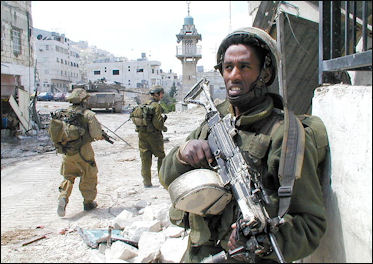
Israeli soldiers in Nablus After terrorist attacks, Israel often closed the borders to the Palestinian territories, cut off food supplies and prevented Palestinians from working in Israel. Siblings of suspected terrorists in the West Bank have been rounded up and placed in fenced in areas of the Gaza Strip. An Israeli court ruled that such banishments were justified in “extreme cases.” The tactic was used with the sister and brother of a suicide bomber that participated in an attack in Tel Aviv. They were picked up by soldiers, allowed to say good bye to their relatives at a military base and then were driven to the Gaza Strip and dropped of the middle of field planted with grapes and figs.
Sometimes retaliatory strikes made against Palestinian targets. Numerous high officials in Hamas, Islamic Jihad and other Palestinian organizations with links to terrorism have been killed by Israeli security forces in what they call “targeted killings” and the Palestinians call assassinations. These attacks have been carried with missiles, bombs, tanks, booby traps and gunfire.
The number of “targeted killing” increased from 35 in 2001 to 72 in 2002. Many of this who were killed were the intended targets. Some were also innocent civilians. In August 2001, Abu Ali Mustafa, the leader of the Front for the Liberation of Palestine (PFLP), the second largest faction of the PLO after Fatah, was decapitated by an Israeli missile while he was reading newspapers at his desk in Ramallah. Two months later, PFLP gunmen retaliated and killed Israeli cabinet minister Rehavam Zeevi outside his room in a Jerusalem hotel. Zeevi was the minister of tourism and a former general who once called Palestinians “lice.”
In April 2001, an Islamic Jihad leader was killed in a booby-trapped public telephone booth. In January 2002, Red Karmi, the leader of the al-Aqsa Martyr’s Brigade, left his safe house in the West Bank town of Tulkarm to visit his pregnant wife and baby daughter in their nearby home. As he walked past a graveyard a bomb exploded and he was blown to bits. The operation was believed to have been carried by Dhin Bet commandos assisted by Palestinian informers. Karmi was said to be involved in 15 terrorist attacks over a 16 month period.
In May 2004, Israel failed in an efforts to kill Islamic Jihad head Mohammed al-Hindi. Israeli helicopters struck Islamic Jihad targets in Gaza including the place where al-Hindi is thought to have lived. The attack was in retaliation for a Palestinian attack that killed 13 Israeli soldiers.
Other assassinated militants include Nazih Abu Sibaa, who died after opened up the booby-trapped trunk of his car; Abdul Rahmad Hamad, who was shot dead by a sniper while he read the Koran ; and Mohammed Abayat, who blown up at pay phone outside a hospital, where he visited his sick mother.
Israeli Attacks Against Hamas in the 2000s
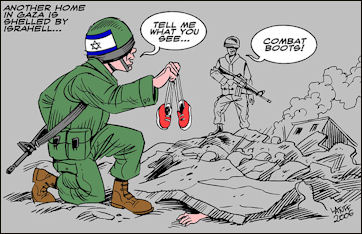
by Carlos Latuff In January 1996, half the head of Yehiya “the Engineer” Ayash, a Hamas bombmaker, was blown off when a booby-trapped cell phone blew up next to his ear. The killing was carried by Shin Bet Israeli intelligence agents. They detonated the bomb from a plane circling overhead when Ayash answered the phone.
In January 2001, Hamas leader Bakr Hamdan was killed by rockets fired at his car in the Khan Younic refugee camp. An Israeli military spokesman said that Hamdan was targeted because he was responsible for “dozens of terrorist attacks carried out against Israeli civilians and soldiers in the Gaza Strip.”
In July 2001, a senior Hamas member, Saleh Darwazeh, was killed by an Israeli missile while he drove on a West Bank road and Hamas leader Jamal Salim was decapitated by an Israeli missile fired from a helicopter gunship while he visited an office in Nablus. In the attack that killed Salim, another Hamas leader, Jamas Mansour, two boys walking by on the street and four others were killed. In October 2001, a leader in the Hamas military wing was blown up at his house on Rafah.
In 2002 Israel said it would target Hamas political leaders not just members of its military wing. In March 2003, Israel killed Ibrahim al-Maqadma, a founder of Hamas and a leader of its military wing. In August 2003, Israel killed Hamas leader Ismail Abu Shanab, regarded by some as a moderate.
In September 2004, the Israelis killed Izz al-deeb, a senior leader of the Hamas military wing with a missile strike on his car as it passed through a Hamas stronghold in Gaza. The missile is believed to have been fired from a drone. Also in September a Hamas official was killed by a car bomb in Damascus Syria. In October, Adnan al-Ghoul, the No. 2 man in Hamas’s military wing, was killed in a missile strike from an unmanned drone. Ghoul was regarded as an expert bomb, rocket and anti-tank missile maker.
Killing of Hamas’s Leaders in the 2004
In March 2004, the Israelis killed Hamas spiritual leader Sheik Ahmed Yassin as he was leaving a mosque in Gaza City. The wheel-chair-bound cleric was the target of three missiles fired from a helicopter. Seven others were killed in the attack. Sharon personally ordered the attack in response to suicide attacks in the port of Ashdod and attempts to blow up toxic chemical storage tanks a few days before. . Hundreds of thousands of Palestinian marched through the streets during the funeral procession, vowing revenge. Israelis took the threat seriously. Afterwards the streets of Jerusalem were deserted.
Sheik Yassa was the highest profile Palestinian leader to be assassinated since Palestinian commando chief Khalil al-Wazir was killed in Tunis in 1988. The operation did not take much intelligence work. The location of Yassin’s house was well known. He visited the mosque he was killed at almost everyday. A witness told Reuters that after the first missile hit, “I looked to see where Sheik Ahmed Yassin was. He was lying on the ground and his wheelchair was destroyed. People then darted left and right. Then another two missiles landed.” Another witness told the Independent, “the side of his head and face had been blown off and he was lying in the road with the wheelchair about a meter away from him.”
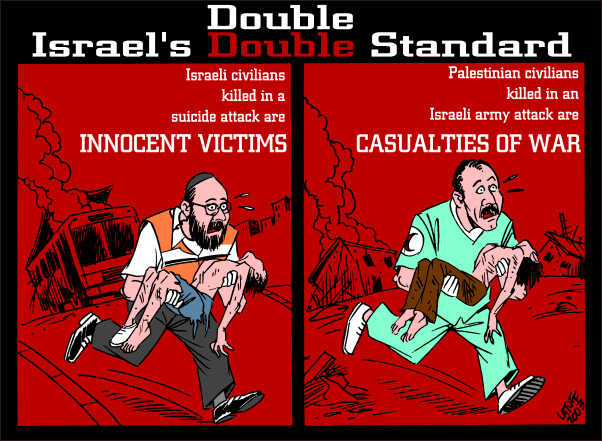
The Yassin assassination was widely condemned by the international community but not the United States. Sharon was not the least bit apologetic. He called Yassin a “mass murder who is among Israel’s greatest enemies.” The Israeli government said it was committed to wiping out the entire Hamas leadership. Yassin himself has survived a missile attack aimed at him in September 2003.
In April 2004, Israel killed the top Hamas leader Abdel Aziz al-Rantisi. Two missiles fired from a helicopter struck Rantisi’s car in Gaza City. The attack occurred hours after a suicide bomber blew himself up at the Erez border crossing in the northern Gaza Strip, killing one Israeli soldier. Israel said it had struck down a “mastermind of terrorism.” Israel killed two others when it tried to assassinate Rantiso in June 2003. Hamas threatened 100 revenge attack but afterward there were few suicide attacks.
Image Sources: Wikimedia Commons
Text Sources: New York Times, Washington Post, Los Angeles Times, Times of London, The Guardian, National Geographic, The New Yorker, Time, Newsweek, Reuters, AP, AFP, Wall Street Journal, The Atlantic Monthly, The Economist, Global Viewpoint (Christian Science Monitor), Foreign Policy, Wikipedia, BBC, CNN, NBC News, Fox News and various books and other publications.
Last updated July 2012
